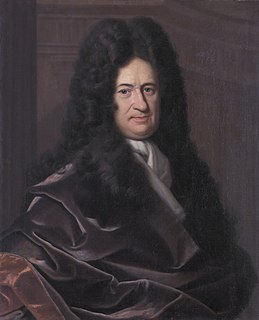Calculus is the mathematical study of continuous change, in the same way that geometry is the study of shape and algebra is the study of generalizations of arithmetic operations.
In mathematics, a continuous function is a function for which sufficiently small changes in the input result in arbitrarily small changes in the output. Otherwise, a function is said to be a discontinuous function. A continuous function with a continuous inverse function is called a homeomorphism.

In mathematics, infinitesimals are things so small that there is no way to measure them. The insight with exploiting infinitesimals was that entities could still retain certain specific properties, such as angle or slope, even though these entities were quantitatively small. The word infinitesimal comes from a 17th-century Modern Latin coinage infinitesimus, which originally referred to the "infinite-th" item in a sequence. Infinitesimals are a basic ingredient in the procedures of infinitesimal calculus as developed by Leibniz, including the law of continuity and the transcendental law of homogeneity. In common speech, an infinitesimal object is an object that is smaller than any feasible measurement, but not zero in size—or, so small that it cannot be distinguished from zero by any available means. Hence, when used as an adjective, "infinitesimal" means "extremely small". To give it a meaning, it usually must be compared to another infinitesimal object in the same context. Infinitely many infinitesimals are summed to produce an integral.
In ring theory, a branch of abstract algebra, a quotient ring, also known as factor ring, difference ring or residue class ring, is a construction quite similar to the quotient groups of group theory and the quotient spaces of linear algebra. One starts with a ring R and a two-sided ideal I in R, and constructs a new ring, the quotient ring R / I, whose elements are the cosets of I in R subject to special + and ⋅ operations.
In category theory, a branch of mathematics, a monad is an endofunctor, together with two natural transformations. Monads are used in the theory of pairs of adjoint functors, and they generalize closure operators on partially ordered sets to arbitrary categories.
In functional programming, a monad is a design pattern that allows structuring programs generically while automating away boilerplate code needed by the program logic. Monads achieve this by providing their own data type, which represents a specific form of computation, along with one procedure to wrap values of any basic type within the monad and another to compose functions that output monadic values.
In non-standard analysis, a branch of mathematics, overspill is a widely used proof technique. It is based on the fact that the set of standard natural numbers N is not an internal subset of the internal set *N of hypernatural numbers.
In model theory, a transfer principle states that all statements of some language that are true for some structure are true for another structure. One of the first examples was the Lefschetz principle, which states that any sentence in the first-order language of fields that is true for the complex numbers is also true for any algebraically closed field of characteristic 0.
In mathematics, non-standard calculus is the modern application of infinitesimals, in the sense of non-standard analysis, to differential and integral calculus. It provides a rigorous justification for some arguments in calculus that were previously considered merely heuristic.
In mathematical logic, in particular in model theory and non-standard analysis, an internal set is a set that is a member of a model.
The term differential is used in calculus to refer to an infinitesimal change in some varying quantity. For example, if x is a variable, then a change in the value of x is often denoted Δx. The differential dx represents an infinitely small change in the variable x. The idea of an infinitely small or infinitely slow change is extremely useful intuitively, and there are a number of ways to make the notion mathematically precise.
Non-standard analysis and its offshoot, non-standard calculus, have been criticized by several authors, notably Errett Bishop, Paul Halmos, and Alain Connes. These criticisms are analyzed below.
In non-standard analysis, a hyperintegern is a hyperreal number that is equal to its own integer part. A hyperinteger may be either finite or infinite. A finite hyperinteger is an ordinary integer. An example of an infinite hyperinteger is given by the class of the sequence (1, 2, 3, ...) in the ultrapower construction of the hyperreals.
Elementary Calculus: An Infinitesimal approach is a textbook by H. Jerome Keisler. The subtitle alludes to the infinitesimal numbers of the hyperreal number system of Abraham Robinson and is sometimes given as An approach using infinitesimals. The book is available freely online and is currently published by Dover.
In non-standard analysis, a discipline within classical mathematics, microcontinuity of an internal function f at a point a is defined as follows:
In mathematics, the transcendental law of homogeneity (TLH) is a heuristic principle enunciated by Gottfried Wilhelm Leibniz most clearly in a 1710 text entitled Symbolismus memorabilis calculi algebraici et infinitesimalis in comparatione potentiarum et differentiarum, et de lege homogeneorum transcendentali. Henk J. M. Bos describes it as the principle to the effect that in a sum involving infinitesimals of different orders, only the lowest-order term must be retained, and the remainder discarded. Thus, if is finite and is infinitesimal, then one sets



